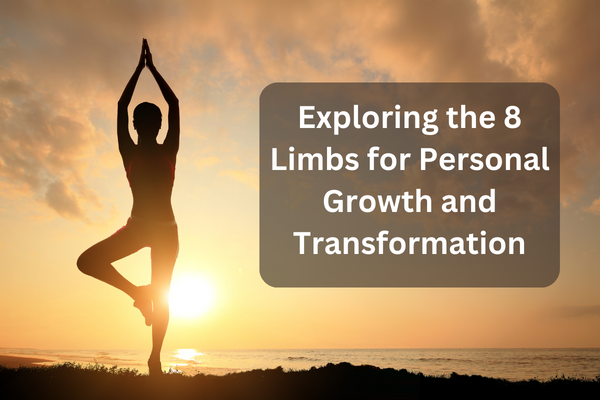Yoga is not just about physical postures; it’s a holistic practice that encompasses ethical principles, breath control, meditation, and more. The 8 Limbs of Yoga, also known as the Ashtanga Yoga, provide a framework for personal growth, self-realization, and spiritual enlightenment. In this blog post, we will dive into each limb, exploring their significance and how they contribute to a meaningful and purposeful life. So, grab your yoga mat, and let’s embark on this enlightening journey together!
What do we mean by the 8 limbs of yoga?
So, what exactly are these Eight Limbs of Yoga? Think of them as eight different parts, or steps, that you can follow to help you live a happier, healthier, and more fulfilling life. Each limb focuses on different aspects of who you are and how you interact with the world around you. By practicing these limbs, you can learn more about yourself, find inner peace, and even discover a deeper connection to the universe.
What does yoga mean?
Before we dive into the Eight Limbs, let’s talk about what yoga is all about. Yoga isn’t just about stretching and bending your body into fancy poses (although that’s part of it too!). Yoga is a whole lot more than that. The word “yoga” comes from an ancient language called Sanskrit, and it means to unite or connect. So, when you practice yoga, you’re not just doing physical exercises; you’re also connecting your body, mind, and spirit. It’s like bringing all the different parts of yourself together to create harmony and balance.
8 Limbs of Yoga:
Yama – Restraints, moral disciplines, or moral vows:
Yama is all about how you interact with the world around you. It’s like a set of rules or guidelines for being a good person. Yama includes things like being kind to others, telling the truth, and not taking things that don’t belong to you.
Niyama – Positive duties or observances:
Niyama is about taking care of yourself and cultivating positive habits. It’s like making a promise to yourself to do things that make you feel good and help you grow as a person. Niyama includes things like keeping yourself clean, being grateful for what you have, and spending time in quiet reflection.
Asana – Posture:
Asana is probably the most well-known limb of yoga. It’s all about the physical postures and poses that you do during a yoga practice. But it’s not just about stretching and bending; it’s also about finding balance, strength, and flexibility in your body.
Pranayama – Breathing Techniques:
Pranayama is all about the breath. It’s about learning to control your breath in order to calm your mind, increase your energy, and connect more deeply with yourself. Pranayama exercises can help you feel more relaxed, focused, and present in the moment.
Pratyahara – Sense Withdrawal:
Pratyahara is like taking a break from the outside world. It’s about turning your attention inward and tuning out distractions. By practicing Pratyahara, you can find a sense of inner peace and quiet amidst the chaos of everyday life.
Dharana – Focused Concentration:
Dharana is all about training your mind to focus on one thing at a time. It’s like giving your brain a workout by concentrating on a single point, like a word, a picture, or your breath. Dharana can help improve your memory, increase your attention span, and reduce stress.
Dhyana – Meditative Absorption:
Dhyana takes Dharana a step further. It’s about letting go of distractions and entering a state of deep meditation. When you practice Dhyana, you can experience a sense of calm, clarity, and inner peace that can be hard to find in our busy lives.
Samadhi – Bliss or Enlightenment:
Samadhi is the ultimate goal of yoga. It’s like reaching the top of a mountain and experiencing a state of pure bliss and oneness with the universe. Samadhi is said to be a state of complete freedom from suffering and the cycle of birth and death.
You May Also Read – Types of Yoga – Explore 9 Different Styles of Yoga
Conclusion:
In conclusion, the eight limbs of yoga provide a comprehensive guide for living a balanced and fulfilling life. By practicing the yamas and niyamas, you can cultivate moral and ethical values that promote harmonious relationships with others and oneself. Through the practice of asana, you can develop strength, flexibility, and balance in the body. Pranayama allows for the regulation of breath, leading to improved physical and mental well-being. Whether you’re a seasoned yogi or just beginning your journey, the Eight Limbs of Yoga provide a roadmap for living a more balanced, harmonious, and fulfilling life.
If you’re interested in deepening your understanding of yoga and becoming a certified instructor, consider enrolling in a yoga instructor course in Pune. Pune is known for its rich yoga heritage and offers a variety of courses to suit every level of experience. By taking the leap to become a yoga instructor, you not only deepen your own practice but also have the opportunity to share the transformative power of yoga with others, spreading health, wellness, and peace in your community and beyond.


